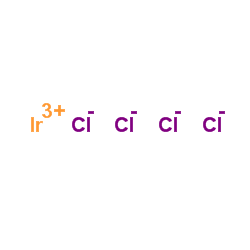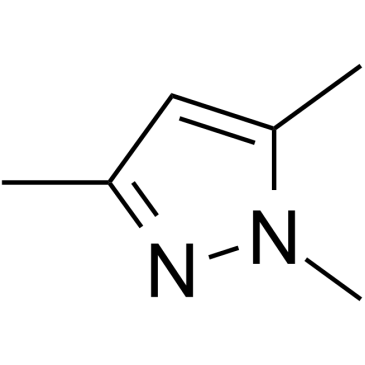10025-83-9
| 中文名 | 氯化铱(III) |
|---|---|
| 英文名 | Iridium(III) chloride |
| 中文别名 | 三氯化铱 |
| 英文别名 |
Iridous chloride
IRIDIUM TRICHLORIDE extrapure MFCD00011063 Iridium trichloride Iridium(3+) trichloride IRIDIUM CHLORIDE EINECS 233-044-6 |
| 密度 | 5,3 g/cm3 |
|---|---|
| 熔点 | 763ºC |
| 分子式 | Cl3Ir |
| 分子量 | 298.576 |
| 精确质量 | 297.869446 |
| 外观性状 | 棕色粉末 |
| 蒸汽压 | 33900mmHg at 25°C |
| 储存条件 | 室温,干燥 |
| 稳定性 | α-IrCl3具有AlCl3类型的结构,为棕色片状固体,在空气中稳定,在600℃加热转变为β-IrCl3。β-IrCl3与α-IrCl3的结构相似,但金属原子在晶格的八面体空隙中的分布方式不同。β-IrCl3是深红色的结晶,在763℃时分解。也存在有一暗橄榄绿色的变体。IrCl3的密度为5.3g/cm3,不溶于水、碱和酸,但可溶于王水中形成[IrCl]2+。 |
| 水溶解性 | insoluble |
| 分子结构 | 1、摩尔折射率:无可用的 2、摩尔体积(cm3/mol):无可用的 3、等张比容(90.2K):无可用的 4、表面张力(dyne/cm):无可用的 5、介电常数:无可用的 6、极化率(10-24cm3):无可用的 7、单一同位素质量:297.869458 Da 8、标称质量:298 Da 9、平均质量:298.576 Da |
| 计算化学 | 1、 疏水参数计算参考值(XlogP):未确定 2、 氢键供体数量:0 3、 氢键受体数量:3 4、 可旋转化学键数量:0 5、 拓扑分子极性表面积(TPSA):0 6、 重原子数量: 4 7、 表面电荷:0 8、 复杂度:0 9、 同位素原子数量:0 10、 确定原子立构中心数量:0 11、 不确定原子立构中心数量:0 12、 确定化学键立构中心数量:0 13、 不确定化学键立构中心数量:0 14、 共价键单元数量:4 |
| 更多 | 1. 性状:棕色无气味粉末。 2. 密度(g/mL,25℃):5.3 3. 相对蒸汽密度(g/mL,空气=1):1未确定 4. 熔点(ºC):763 5. 沸点(ºC,常压):未确定 6. 沸点(ºC,5.2kPa):未确定 7. 折射率:未确定 8. 闪点(ºC):未确定 9. 比旋光度(º):未确定 10. 自燃点或引燃温度(ºC):未确定 11. 蒸气压(kPa,20ºC):未确定 12. 饱和蒸气压(kPa,60ºC):未确定 13. 燃烧热(KJ/mol):未确定 14. 临界温度(ºC):未确定 15. 临界压力(KPa):未确定 16. 油水(辛醇/水)分配系数的对数值:未确定 17. 爆炸上限(%,V/V):未确定 18. 爆炸下限(%,V/V):未确定 19. 溶解性:不溶于水 |
Synonym:Iridium Muriate Section 2 - COMPOSITION, INFORMATION ON INGREDIENTS
Risk Phrases: None Listed. Section 3 - HAZARDS IDENTIFICATION EMERGENCY OVERVIEW
Moisture sensitive.The toxicological properties of this material have not been fully investigated. Potential Health Effects Eye: May cause eye irritation. Skin: May cause skin irritation. Ingestion: May cause irritation of the digestive tract. The toxicological properties of this substance have not been fully investigated. Inhalation: May cause respiratory tract irritation. The toxicological properties of this substance have not been fully investigated. Chronic: No information found. Section 4 - FIRST AID MEASURES Eyes: Flush eyes with plenty of water for at least 15 minutes, occasionally lifting the upper and lower eyelids. Get medical aid. Skin: Get medical aid. Flush skin with plenty of water for at least 15 minutes while removing contaminated clothing and shoes. Wash clothing before reuse. Ingestion: Never give anything by mouth to an unconscious person. Get medical aid. Do NOT induce vomiting. If conscious and alert, rinse mouth and drink 2-4 cupfuls of milk or water. Inhalation: Remove from exposure and move to fresh air immediately. If not breathing, give artificial respiration. If breathing is difficult, give oxygen. Get medical aid. Notes to Physician: Section 5 - FIRE FIGHTING MEASURES General Information: As in any fire, wear a self-contained breathing apparatus in pressure-demand, MSHA/NIOSH (approved or equivalent), and full protective gear. During a fire, irritating and highly toxic gases may be generated by thermal decomposition or combustion. Use extinguishing media appropriate to the surrounding fire. Substance is noncombustible. Extinguishing Media: Substance is noncombustible; use agent most appropriate to extinguish surrounding fire. Do NOT get water inside containers. Use water spray, dry chemical, carbon dioxide, or appropriate foam. Section 6 - ACCIDENTAL RELEASE MEASURES General Information: Use proper personal protective equipment as indicated in Section 8. Spills/Leaks: Vacuum or sweep up material and place into a suitable disposal container. Clean up spills immediately, observing precautions in the Protective Equipment section. Avoid generating dusty conditions. Provide ventilation. Do not get water inside containers. Section 7 - HANDLING and STORAGE Handling: Wash thoroughly after handling. Use with adequate ventilation. Minimize dust generation and accumulation. Avoid contact with eyes, skin, and clothing. Keep container tightly closed. Avoid ingestion and inhalation. Do not allow contact with water. Keep from contact with moist air and steam. Storage: Store in a tightly closed container. Store in a cool, dry, well-ventilated area away from incompatible substances. Storage under a nitrogen blanket has been recommended. Store protected from moisture. Section 8 - EXPOSURE CONTROLS, PERSONAL PROTECTION Engineering Controls: Facilities storing or utilizing this material should be equipped with an eyewash facility and a safety shower. Use adequate ventilation to keep airborne concentrations low. Exposure Limits CAS# 10025-83-9: Personal Protective Equipment Eyes: Wear appropriate protective eyeglasses or chemical safety goggles as described by OSHA's eye and face protection regulations in 29 CFR 1910.133 or European Standard EN166. Skin: Wear appropriate protective gloves to prevent skin exposure. Clothing: Wear appropriate protective clothing to prevent skin exposure. Respirators: A respiratory protection program that meets OSHA's 29 CFR 1910.134 and ANSI Z88.2 requirements or European Standard EN 149 must be followed whenever workplace conditions warrant respirator use. Section 9 - PHYSICAL AND CHEMICAL PROPERTIES Physical State: Crystals Color: dark brown - grey Odor: Not available. pH: Not available. Vapor Pressure: Not available. Viscosity: Not available. Boiling Point: Not available. Freezing/Melting Point: 763 deg C Autoignition Temperature: Not applicable. Flash Point: Not applicable. Explosion Limits, lower: Not available. Explosion Limits, upper: Not available. Decomposition Temperature: Solubility in water: Specific Gravity/Density: Molecular Formula: Cl3Ir Molecular Weight: 298.56 Section 10 - STABILITY AND REACTIVITY Chemical Stability: Stable at normal temperatures in tightly closed containers under an inert atmosphere. Conditions to Avoid: Incompatible materials, dust generation, moisture, excess heat. Incompatibilities with Other Materials: Moisture, strong oxidizing agents. Hazardous Decomposition Products: Hydrogen chloride, chlorine, irritating and toxic fumes and gases. Hazardous Polymerization: Has not been reported Section 11 - TOXICOLOGICAL INFORMATION RTECS#: CAS# 10025-83-9 unlisted. LD50/LC50: Not available. Carcinogenicity: Iridium(III) Chloride - Not listed by ACGIH, IARC, or NTP. Section 12 - ECOLOGICAL INFORMATION Section 13 - DISPOSAL CONSIDERATIONS Dispose of in a manner consistent with federal, state, and local regulations. Section 14 - TRANSPORT INFORMATION IATA Not regulated as a hazardous material. IMO Not regulated as a hazardous material. RID/ADR Not regulated as a hazardous material. Section 15 - REGULATORY INFORMATION European/International Regulations European Labeling in Accordance with EC Directives Hazard Symbols: Not available. Risk Phrases: Safety Phrases: S 24/25 Avoid contact with skin and eyes. S 28A After contact with skin, wash immediately with plenty of water. S 37 Wear suitable gloves. S 45 In case of accident or if you feel unwell, seek medical advice immediately (show the label where possible). WGK (Water Danger/Protection) CAS# 10025-83-9: 2 Canada CAS# 10025-83-9 is listed on Canada's DSL List. CAS# 10025-83-9 is not listed on Canada's Ingredient Disclosure List. US FEDERAL TSCA CAS# 10025-83-9 is listed on the TSCA inventory. SECTION 16 - ADDITIONAL INFORMATION N/A |
|
生态学数据: 通常对水体是稍微有害的,不要将未稀释或大量产品接触地下水,水道或污水系统,未经政府许可勿将材料排入周围环境。
|
| 符号 |

GHS07 |
|---|---|
| 信号词 | Warning |
| 危害声明 | H315-H319-H335 |
| 警示性声明 | P261-P305 + P351 + P338 |
| 个人防护装备 | dust mask type N95 (US);Eyeshields;Gloves |
| 危害码 (欧洲) | Xi:Irritant |
| 风险声明 (欧洲) | R36/37/38 |
| 安全声明 (欧洲) | S26-S36 |
| 危险品运输编码 | UN 1759 |
| WGK德国 | 3 |
|
~% 
10025-83-9 |
| 文献:Journal of the Chemical Society, Chemical Communications, , # 18 p. 1429 - 1430 |
|
~% 
10025-83-9 |
| 文献:Nippon Kagaku Kaishi (Journal of the Chemical Society of Japan), , vol. 63, p. 1938 - 1943 |
| 上游产品 2 | |
|---|---|
| 下游产品 1 | |




